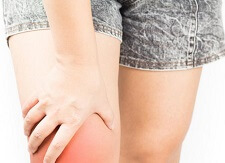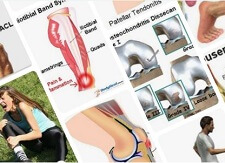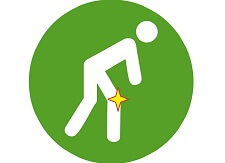- Home
- Knee Exercise Guide
- Intermediate Exercises
Best Leg Exercises:
Intermediate Level
Written By: Chloe Wilson, BSc(Hons) Physiotherapy
Reviewed by: KPE Medical Review Board
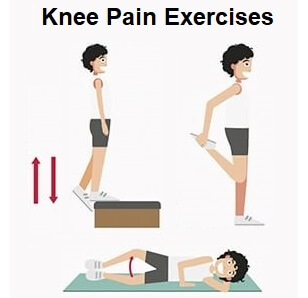
What are the best leg exercises for knee pain? It's such a common question and over many years, working with hundreds of patients, I’ve pulled together a selection of mid-level exercises that I have found work well for all sorts of knee pain.
Here you will find some of the best leg exercises incorporating strengthening, balance and stretching exercises that can help many causes of knee pain.
Muscles can get weak and tight over time or after an injury without us really noticing. When this happens, it changes the way the knee moves and how the forces go through the knee which causes pain. Most causes of knee pain will benefit from knee exercises.
The exercises here are mid-level exercises. If they feel too strenuous or your knee movement is quite restricted, try
simpler
exercises first. However if you are looking for something more challenging, visit the
advanced
exercises section.
To get the most out of these best leg exercises, visit the top tips on exercising section before you start and always check with your doctor before starting on a new rehab program.
Best Leg Exercises For Strength
Here you will find six of the best leg exercises for increase strength. Strengthening the leg muscles is one of the best ways to reduce most causes of knee pain. You should notice an improvement after 3-4 weeks of doing these exercises, if you do them regularly.
1. Bridging: Stage 1
Purpose: One of the best leg exercises for increasing all-round strength and control - strengthens the hamstrings whilst also working the quads and buttock muscles. Also helps develop core strength and stability

Starting Position: Lie on your back with both knees bent about 90° and your feet on the floor/bed
Action: Clench your buttocks and lift your bottom off the bed as high as you can without arching your back. Hold for 3-5 seconds and slowly lower
Repetitions: Repeat 10-25 times, 1-2x daily
Note: 1. Keep your back straight – don’t let it arch as you lift up, make your bottom doing the work
2. Don’t hold your breath – keep breathing normally
3. Don’t let your knees drop out – imagine you are trying to hold a tennis ball between your knees
Progression: Use resistance bands for more of a challenge. Either place a loop band just above your knees and push out gently against the band or place a longer band over the top of your thighs and anchor the band in your hands - as you lift up you will have to work harder to push up against the band
2. Wall Squats
Purpose: One of the best leg exercises for strengthening the quadriceps. A little twist on normal squats – doing them against the wall reduces the pressure going through the knee compared to conventional squats whilst still increasing the strength

Starting Position: Stand with your back against a wall, feet about 6 inches from the wall, knees apart, toes pointing forward
Action: Slide down the wall, allowing your knees to bend. Hold for a few seconds and then push back up
Repetitions: Repeat 10-25x, 2x daily
Progression: 1. Increase the depth of the dip (up to 90°)
2. Hold the bent knee position for longer (aiming for 10secs)
Note: As you squat, don’t let your knees come too far in or out - Keep your knee in line with your second toe so you can always see your big toe past the inside of your knee
3. The Clam
Purpose: One of the best leg exercises for strengthening the buttock muscles. Almost everyone I've seen with knee pain has weak glutes. The glutes help support the knee and make sure the forces are evenly spread throughout the joint.

Starting position: Lie on your side with your hip and knees bent approx 90°, feet together
Action: Keeping your feet together, lift the top knee up as high as you can. Hold for 3 seconds and slowly lower
Repetition: Repeat 10-25x on each side, 2x daily
Note: Do not let your top hip roll backwards
Progression: Place a loop resistance band around your lower thighs, just above your knees. You will have to work much harder to lift up against the band
4. Step Ups
Purpose: Strengthen the quadriceps and improve knee control/stability

Starting Position: Stand facing the bottom of the stairs/single step and put the leg you want to strengthen up on the step. Hold onto the wall/rail for support if required
Action: Slowly, step your other leg up onto the step and then lower it back down to the floor.
Repetition: Repeat 10-30 times, 2x daily
Progression: 1. Don’t hold onto anything
2. the slower you do the exercise, the harder it will work your knee muscles
Note:
1. Make sure you can see your big toe at all times – keep your kneecap
in line with your second toe, don’t let the knee fall inwards
2. If you don’t have any steps at home, be creative e.g. large book
5. Side Step Downs
Purpose: Strengthen the quadriceps, improve balance, improve knee stability

Starting Position: Stand sideways on top of a step. Hold the wall/rail for support
Action: Slowly lower your good leg down to the floor and then bring it back up (keeping your other foot up on the step throughout)
Repetition: Repeat 5-20x, 2x daily
Progression: Stand facing forwards and step down instead of sideways, lightly touching the good leg to the floor
Note: 1) You are aiming to do this in a slow, controlled fashion
2) Don’t let the knee twist inwards
6. Solo Heel Raises
Purpose: Strengthen the calf muscles to help support the knee

Starting Position: Stand on one leg holding onto something stable for balance
Action: Push up onto your tiptoes so your heel is up of the ground as high as you can. Hold for 3-5 secs and slowly lower
Repetition: Repeat 10-30 times, 2x daily
Target: When you can do 30 repetitions on a single leg, that is a good sign you have good strength in your calf muscles
Best Leg Exercises For Balance
Good balance/proprioception is really important to prevent knee injuries. As a quick test to see whether you would benefit from this exercise try standing on one leg with your eyes closed. If you can’t do it for 1 minute, you would benefit from this exercise.
This is one of the most simple but best leg exercises to help your body learn the subtle adjustments needed for good balance.
1. Single Leg Standing
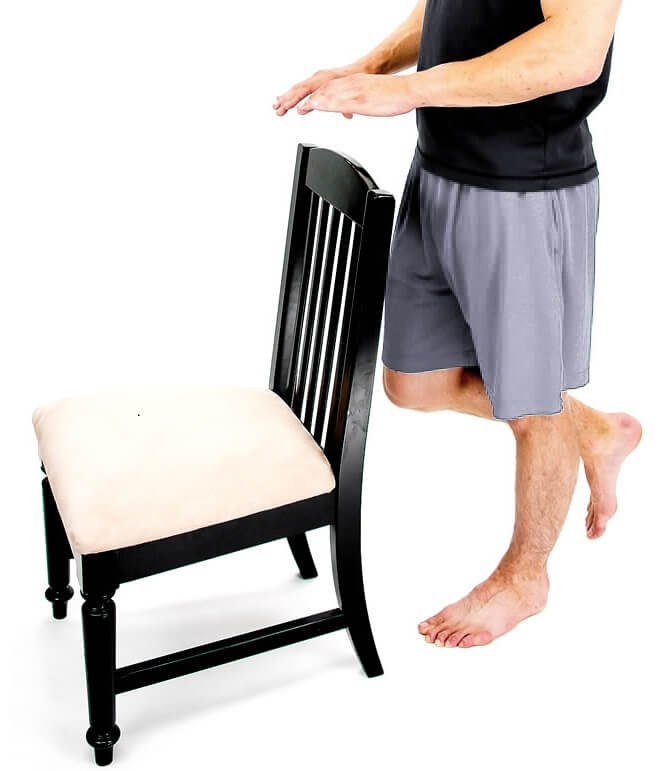
Starting Position: Standing either by a chair or next to the wall
Action: Lift up your good leg and stand on one leg for as long as you can
Repetition: Spend 5 minutes doing this 2x daily
Progression: 1. Close your eyes and perform the exercise as above
2. Open eyes and throw and catch a ball
3. Slowly bend and straighten your knee a small amount while doing the exercise
Best Leg Stretches
Tight muscles are a common cause of knee pain. If the muscles are tight, it changes the way the knee moves and alters how the forces are distributed through the knee.
Here you will find the best leg exercises for stretching the quads and hamstrings as these are the most common muscles to be tight. Visit the knee stretches section for a quick test to see if your muscles are tight and you would benefit from stretches, or for different ways of stretching these muscles.
You will also find the best leg exercises for stretching the glutes, ITB and calf muscles there.
1. Lying Quads Stretch
Purpose: Best leg exercises to stretch the quads muscles. Quads tightness is a common feature in knee problems
When To Do: Before and after exercise, most knee problems
Starting Position: Lie flat down on your tummy
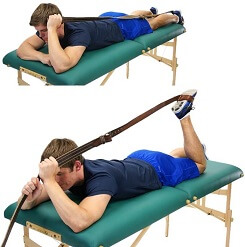
Action: Bring your heel towards your bottom pulling at the ankle until you feel a stretch in the front of your thigh – if you can’t reach your ankle put a towel or belt around your foot and pull that. Hold for 30 secs
Repetition: Repeat 3 times, 2x daily, or before and after exercise
Progression: 1. Prop yourself up on your elbows and carry out the exercise as described above
2. Place a pillow/rolled up towel under your knee and carryout the
exercise as described above. Combine with progression 1 to stretch
further
2. Standing Hamstring Stretch
Purpose: Best leg exercises to stretch the hamstring muscles
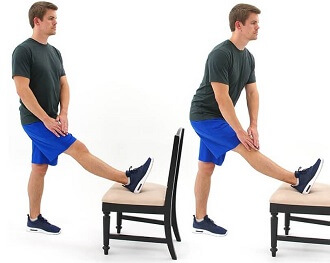
When To Do: Before and after exercise, most knee problems
Starting Position: Find a stool or object that is about 50cms / 1 ½ foot high. Leave one foot on the floor and rest the other foot on the stool with the knee slightly bent (about 15°)
Action: Lean forwards and down, keeping your back straight, until you feel a stretch in the middle of the back of the thigh. Hold for 30 secs
Repetition: Repeat 3 times, 2x daily, or before and after exercise
Tips: 1. You want to feel the stretch in the middle of the thigh rather than
behind the knee – bending the knee slightly helps to achieve this
2. If you do not feel much of a stretch, lean slightly to the side of the
leg being stretched as well as forwards and you may feel more of a
stretch
What Else Can Help?
There are lots of exercises that can help knee pain. Try them out and chose the best leg exercises for you. They should be moderately challenging but not painful. See the exercise overview for tips on working at the right level for you.
If these exercises feel too hard at the moment, do the beginners exercises for a few weeks, and once you have built up some more strength, come back to these intermediate best leg exercises.
Once you have done these intermediate best leg exercises for a few weeks, you should have built up the number of repetitions of each exercise and they should be starting to feel quite easy.
When that is the case, CONGRATULATIONS! You are ready to progress on to more advanced knee pain exercises to help build up more strength and flexibility.
Remember with any knee problem, you should always see your doctor before you start exercising, but once you get the all clear, you’re ready to go with these best leg exercises for knee pain.
You may also be interested in the following articles:
- Front Knee Swelling
- Pain Behind The Knee
- Sharp Knee Pain
- Knee Pain Diagnosis Chart
- How To Improve Knee Flexibility
- How To Sleep Well With Knee Pain
Page Last Updated: 12/12/23
Next Review Due: 12/12/25
